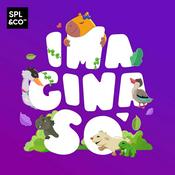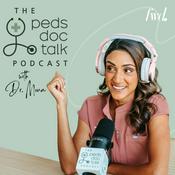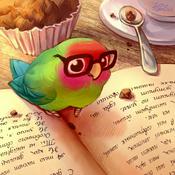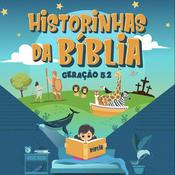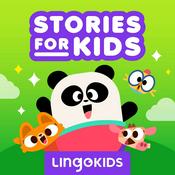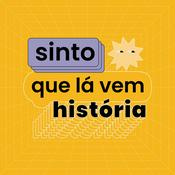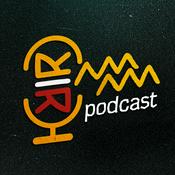92 episódios

How phonics can support children with dyslexia
08/1/2025 | 18min
As you may know, Lovevery now offers The Reading Skills Set. It's a phonics-based program that makes reading fun, motivating your child to read through play. It covers skills from pre-K through Second grade. In this episode, My New Life host Jessica Rolph talks with Sprout Labs CEO Carla Small about the neuroscience behind dyslexia, and why it has nothing to do with reversing letters. Carla and Dr. Nadine Gaab created EarlyBird, an early literacy assessment used in school districts nationwide. Mentioned in this episode: Brought to you by Lovevery.com SproutLabs.com Receive weekly emails about your child's development, and stay in the know about new play essentials, promos, and more by signing up at Lovevery.com Follow Lovevery and Jessica Rolph on Instagram

Teaching toddlers to read
30/10/2024 | 27min
This bonus episode features an interview with Spencer Russell, the dad behind Toddlers Can Read. Spencer struggled to learn to read as a kid, so when it came time to choose a career, he set out to help others avoid the same experience and took a job with Teach for America, continuing as a kindergarten and first-grade teacher in Houston, Texas. When he started teaching, Spencer's students were scoring well below average on national standardized tests. But by the time he stepped away from the profession, 60% of his students advanced 1.5 years in their reading skills, and over half scored at or above the 82nd percentile, earning him national recognition. After becoming a parent, Spencer focused on his son, teaching him letter sounds at 18 months. By 2 years old, his son was reading on his own! Which is the genesis of Spencer's program, Toddlers Can Read. So effective are his tips for teaching reading, his social channels have over half-a-billion views. We at Lovevery teamed up with Spencer to create the best at-home reading program in the world, The Reading Skills Set. Takeaways: Make it a game: Children often learn literacy skills early when it feels like play. Teaching them to read sooner gives them more time to master these foundational skills. Start simple: Begin with just three sounds and review them for a few seconds, multiple times a day. As your child grows, you can gradually extend the length of your practice sessions. Turn learning into fun: Spencer suggests making the process playful. For example, have your child say the sound correctly before throwing a ball at the letter, making it an interactive game. Teach blending: Once your child grasps individual sounds, help them blend the sounds into words. Practice orally or using paper. For instance, review how "iii" and "nnn" makes "in" — slowly and patiently. Feeling motivated? Here are 4 signs your child is ready to read: They have strong oral language skills and can pronounce most sounds. They show a good memory. They can focus on sound games. You feel confident in supporting their reading journey! Spencer's literacy materials can be found at ToddlersRead.com, including a free Beginning Reading Workshop aimed at empowering parents to teach their toddlers to read. Plus, get access to a limited-time, webinar-only discount on the new Reading Skill Set by Lovevery. Mentioned in this episode: Brought to you by Lovevery.com ToddlersRead.com Receive weekly emails about your child's development, and stay in the know about new play essentials, promos, and more by signing up at Lovevery.com Follow Lovevery and Jessica Rolph on Instagram

Montessori math
15/5/2024 | 23min
Math is all around us. When it comes to teaching it, the challenge lies not in creating the opportunities, but in recognizing them. Counting grapes while they disappear is a fun one! Around the age of 4, a child's mathematical knowledge takes a big leap forward. They go from counting and recognizing numbers, to understanding 1:1 correspondence and being able to complete simple addition. As parents, we can support them in this leap by providing things to count, line up, and compare. Lovevery's Montessori Math Bars & Number Tiles for months 43-45 are a great place to start. On this episode, My New Life Host Jessica Rolph is joined by the principal investigator for Boston College's Thinking and Learning Lab, which studies cognitive development with a primary focus on mathematical knowledge: Dr. Elida Laski. Dr. Laski is also on the editorial board of the Journal of Montessori Research. Takeaways: By supporting early math, we're activating the same pathways in the brain that will support literacy. For example, knowing that the symbol 3 refers to three objects is the same thing a child has to do in early reading when they look at an arbitrary combination of lines that represent a B and know that it makes the sound buh. Beyond learning the numbers, exposing children to early visual repeating patterns like red, blue, red, blue, also builds a foundation for later math learning. There's research that shows that labeling the count set after you've counted with your child can make a big difference. So don't just count 1, 2, 3, 4, 5 and assume your child knows that represents five. Go the extra step, and say: "So we have five pegs." This concept is demonstrated in the Lovevery wooden counting box. The Lovevery Montessori math bars not only show that numbers represent a larger quantity as you move up the count sequence, but also visually show how much more. You can reinforce this in the day-to-day, by asking your child: How many more floors do we have to go to get to number 6? Rather than leaning on tools like flashcards, Elida recommends more authentic math activities, where you're: counting real things; comparing who has more crackers, who has fewer; and placing things in order so that you can see their relation to the count sequence. Mentioned in this episode: Brought to you by Lovevery.com Receive weekly emails about your child's development, and stay in the know about new play essentials, promos, and more by signing up at Lovevery.com Follow Lovevery and Jessica Rolph on Instagram

Montessori handwriting
08/5/2024 | 22min
The Montessori method is rooted in the idea that children can—and should—be empowered to do things on their own. On this episode of My New Life, we consider handwriting through a Montessori lens. But how much independence can we truly expect from a child who is forming words on paper for the first time? You may be surprised to learn that a toddler can start practicing handwriting as early as age 3. It all comes down to building the foundations through play! Host Jessica Rolph is joined by Julia Volkman, who wrote her thesis at Harvard on the moveable alphabet. Julia, founder of Maitri Learning, says writing comes online for developing brains before reading. Takeaways: Julia points out that a child's capacity to understand letter sounds is there before their capacity to write them or read them. The Montessori moveable alphabet is extremely helpful in familiarizing children with how these sounds fit together. They move into place the tiles that make the sounds mmm — ooo — pp and, voila, they have a word! MOP. The more a child succeeds at building these words, the more readily they will start to read, and then write… and over time, their spelling will refine. This is the gradual, organic process that happens when they have the right conditions and the materials to support their learning. When it comes to handwriting, the physical aspects are often what we think about: for example, the muscular ability to hold the pencil. But there are also intellectual aspects like the desire to write — and knowing enough about the world around them to find inspiration. Vocabulary and sequencing also play important roles. Vocabulary development comes naturally with your child's exposure to lots of songs, rhymes and books. Give them the words for everything — and remember to keep it playful! Montessori uses lots of indirect preparation, like scrubbing and preparing food to strengthen hand muscles and coordination. You can also practice sequencing in the kitchen by laying out ingredients from left to right, in the order you will use them. Mentioned in this episode: Brought to you by Lovevery.com Receive weekly emails about your child's development, and stay in the know about new play essentials, promos, and more by signing up at Lovevery.com Follow Lovevery and Jessica Rolph on Instagram

Montessori literacy
01/5/2024 | 22min
Even if your 3-year-old can recite their ABCs like a pro, they'll need to learn that spoken words are made up of individual sounds to succeed at reading. Hands-on activities that build this kind of phonemic awareness — and reinforce the connection between letter sounds and letter shapes — are the best way to teach them what they need to know. As with all kinds of hands-on learning, Montessori is a great place to start! Did you know that in Montessori classrooms, children learn to spell before they learn to read? Word building with the moveable alphabet is at the heart of this process. In this first episode in the Montessori series, My New Life Host Jessica Rolph is joined by Laura Saylor, co-author of Powerful Literacy in the Montessori Classroom. Takeaways: The reading journey starts with building your child's phonemic awareness. In other words, playing with sounds. Begin recognizing initial sounds, and then move to the sounds at the end and middle of words. "I spy with my little eye something that ends with the sound dd." Rather than memorizing the ABCs, Montessori teachers will often start with letter sounds. Once the sounds are mastered, they will move to the names of the letters. In the Montessori world, children learn to spell before they learn to read. Word building with the moveable alphabet is at the heart of this process. Try focusing on one sound at a time, creating a variety of 3-letter words with the short U, for example: sun, gum, bun. Lovevery has a moveable alphabet game that capitalizes on a 4 year old's enthusiasm for little objects by rewarding them with a tiny object representing the word they spell. Mentioned in this episode: Brought to you by Lovevery.com Powerful Literacy in the Montessori ClassroomReceive weekly emails about your child's development, and stay in the know about new play essentials, promos, and more by signing up at Lovevery.com Follow Lovevery and Jessica Rolph on Instagram
Mais podcasts de Crianças e família
Podcasts em tendência em Crianças e família
Sobre My New Life
Ouça My New Life, D.P.A. - As Férias dos Detetives do Prédio Azul e muitos outros podcasts de todo o mundo com o aplicativo o radio.net
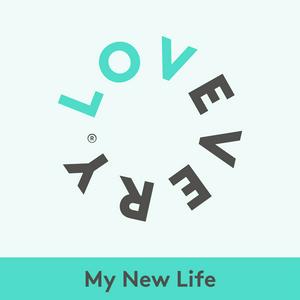
Obtenha o aplicativo gratuito radio.net
- Guardar rádios e podcasts favoritos
- Transmissão via Wi-Fi ou Bluetooth
- Carplay & Android Audo compatìvel
- E ainda mais funções
Obtenha o aplicativo gratuito radio.net
- Guardar rádios e podcasts favoritos
- Transmissão via Wi-Fi ou Bluetooth
- Carplay & Android Audo compatìvel
- E ainda mais funções


My New Life
baixe o aplicativo,
ouça.



